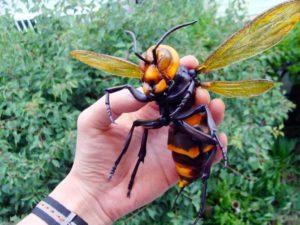The Asian hornet (Vespa Mandarinia) is the largest species not only in Japan, but also in the world.
The largest hornet in the world is Asian. A poisonous representative of this family is found in exotic countries. Many travelers come across this unique insect called the Vespa Mandarinia. The Chinese called it the tiger bee, and the Japanese called it the sparrow bee.
Content
Description of the Asian hornet
The Asian variety is much larger than the European one. For the most part they are similar. However, a closer look reveals some differences. The body is yellow, but with thicker black stripes. The European hornet has a dark red head, while the Asian hornet has a yellow head.
The size varies from 5 to 5,1 cm. The wingspan is 7,5 cm. The length of the sting is 0,8 cm. The length of the body can be compared with the size of the male little finger. The wingspan is almost equal to the width of the palm.
Life cycle
Hornets live in a nest. Nest Founder uterus or queen. She chooses a place to live and builds a honeycomb. The queen herself takes care of the first offspring. After 7 days, larvae appear, which after 14 days become pupae.
Areal
The name refers to the habitat of the insect. More precisely, the geographical location is in the eastern and partly southern and northern parts of Asia. Favorite places to stay are located in:
- Japan
- PRC;
- Taiwan;
- India;
- Sri Lanka;
- Nepal;
- North and South Korea;
- Thailand;
- Primorsky and Khabarovsk Territories of the Russian Federation.
Due to the quick ability to adapt to different conditions, Asian giant wasps master new places. Most of all they prefer sparse forests and lighted groves. Steppe, desert, highlands are not suitable for nesting.
Diet
The hornet can be called an omnivore, as it feeds on insects. It can even eat its small relatives. The diet consists of fruits, berries, nectar, meat, fish. Plant foods are preferred by adults.
The insect obtains food with the help of powerful jaws. The sting is not used for hunting. With its jaws, the hornet catches prey, killing and cutting it into pieces.
Asian hornet control methods
When nests are found, they try to get rid of such neighbors. Destroying a nest mechanically is dangerous and difficult. The whole colony unites and stands up to protect its home. Home defense is the most common cause of death for individuals.
You can eliminate the nest using:
- setting fire to a paper house doused with fuel in advance;
- pouring 20 liters of boiling water;
- drowning with horizontal attachment to the surface;
- spraying a strong insecticide. Be sure to wrap the bag and tie the edges.
Any actions are performed in the evening, when it gets dark. Insect activity is greatly reduced during this time. It is worth noting that the hornet does not sleep at night. He can freeze for half a minute in a stationary state. Work is carried out in glasses, a mask, gloves, a special suit.
Harm from the Asian hornet
Insects destroy apiaries. Huge damage is done to agriculture in countries such as Japan, India, Thailand. During one season, giant wasps can eliminate about 10000 bees.
Insect venom is toxic. Due to the size of the sting, the dose of toxins penetrates in greater quantities than from other hornets.
The most dangerous action of mandorotoxin. It has a nerve agent effect. Poisonous substances cause severe pain. Especially it is necessary to beware of people who are allergic to wasps and bees.
Thanks to the 5% content of acetylcholine, an alarm is given to fellow tribesmen. After a few minutes, the victim is attacked by a whole colony. Only females attack. Males have no sting.
Bite relief measures
When bitten, inflammation spreads quickly on the skin area, swelling appears, lymph nodes increase, and fever appears. The affected area becomes red.
As toxins enter the bloodstream, the following may appear:
- shortness of breath and difficulty breathing;
- dizziness and loss of consciousness;
- headache;
- nausea;
- tachycardia.
When providing first aid:
- Lay down the victim, leaving the head in a raised state.
- Do an injection of "Dexamethasone", "Betamezone", "Prednisolone". Tablets are allowed.
- Disinfected with hydrogen peroxide, alcohol, iodine solution.
- Apply ice.
- The process of absorption into the blood is hampered by the action of a sugar compress.
- Go to the hospital if the condition worsens.
Conclusion
The Asian hornet is distinguished by its huge size and serious consequences of bites. Statistics show that up to 40 Japanese die from their bites every year. Being in these countries, you must be extremely careful and remember that giant insects attack only if their life or nest is threatened.
Previous
